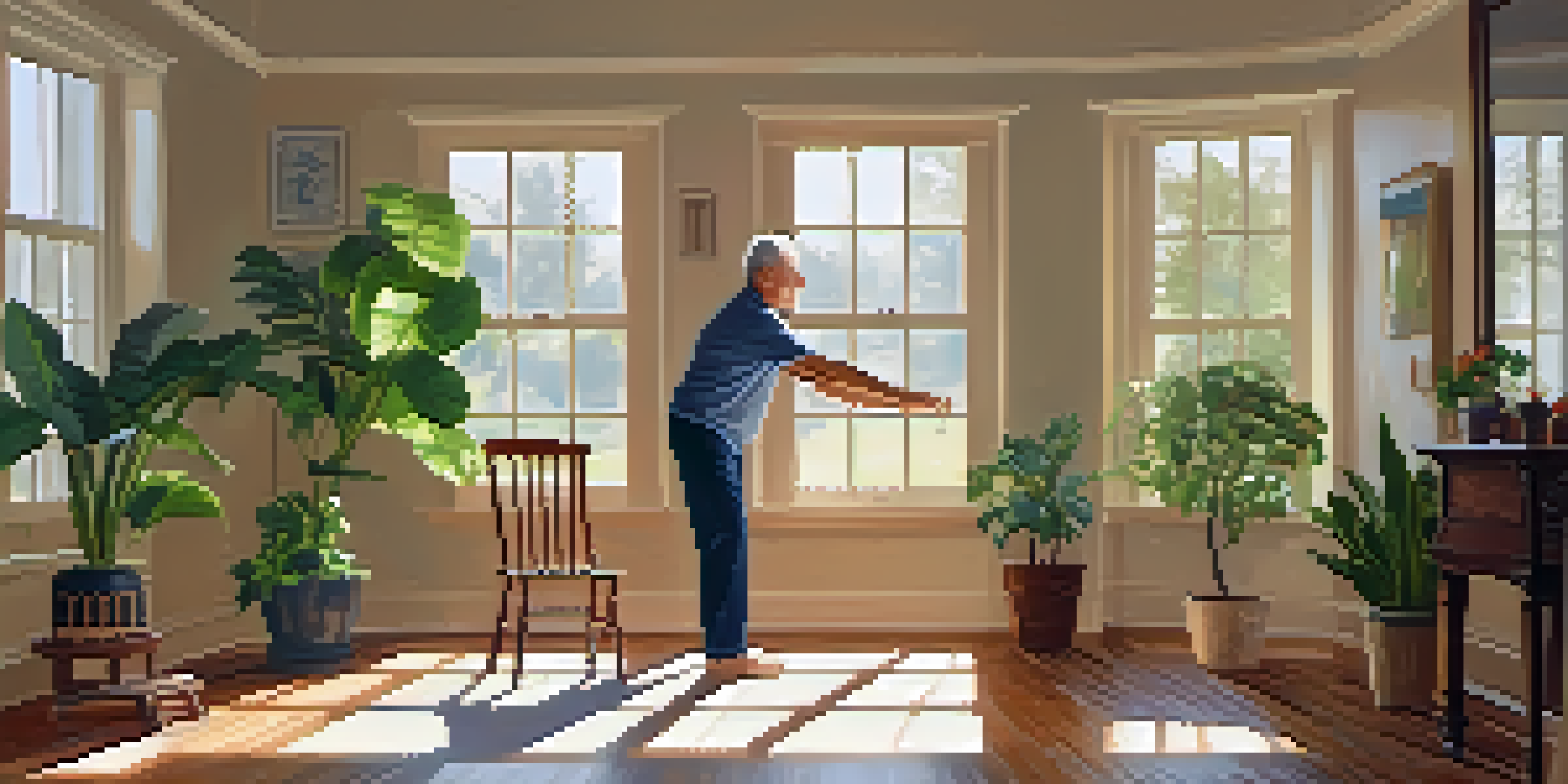The Importance of Balance Training for Older Adults

Understanding Balance Training and Its Importance
Balance training involves exercises that enhance coordination and stability, crucial for maintaining independence as we age. For older adults, these exercises help prevent falls, a leading cause of injury and hospitalization. By focusing on balance, seniors can improve their overall physical performance, which is vital for daily activities, from walking to climbing stairs.
The key to longevity is balance – in everything from diet to exercise to lifestyle.
It’s important to recognize that balance can deteriorate with age due to various factors, including muscle weakness and decreased flexibility. Regular balance training helps counteract these effects, enabling older adults to remain active and engaged in life. Moreover, improving balance can lead to increased confidence, reducing the fear of falling that often limits mobility.
Incorporating balance training into a regular exercise routine is not only beneficial but essential. Studies show that older adults who engage in balance exercises are less likely to suffer serious injuries from falls. Therefore, understanding and implementing balance training is a proactive step toward a healthier and more active lifestyle.
Key Benefits of Balance Training for Seniors
One of the primary benefits of balance training is fall prevention. Falls can lead to severe injuries, such as fractures or head trauma, which can significantly impact an older adult’s quality of life. By engaging in balance exercises, seniors can develop the strength and coordination needed to navigate their environment safely.

Additionally, balance training enhances mobility and agility. Simple tasks like turning around or reaching for an object can become risky without proper balance. Through regular training, older adults can perform these tasks with ease, fostering a sense of independence and confidence in their movements.
Balance Training Prevents Falls
Engaging in balance exercises significantly reduces the risk of falls, which are a leading cause of injury among older adults.
Another advantage is the improvement in overall physical health. Balance exercises often incorporate strength and flexibility training, which contribute to better posture and alignment. This holistic approach not only aids in balance but also boosts cardiovascular health, making it a vital part of any fitness regimen for older adults.
Types of Balance Exercises for Older Adults
There are various types of balance exercises suitable for older adults, ranging from simple to more advanced. Basic exercises include standing on one leg or walking heel-to-toe, which can easily be done at home with little to no equipment. These foundational movements help develop the core stability necessary for more complex activities.
As we age, it becomes increasingly important to maintain our balance, both physically and in our lives.
As individuals progress, they can incorporate more dynamic exercises, such as tai chi or yoga, both of which emphasize balance through controlled movements. These practices not only improve balance but also promote relaxation and mental well-being, creating a holistic experience. Group classes can also foster social interaction, which is beneficial for emotional health.
Using props like balance boards, stability balls, or even simple household items can make workouts more engaging and fun. Incorporating variety keeps seniors motivated and encourages them to stick with their routine. The key is to choose exercises that are enjoyable and tailored to individual abilities.
How to Start a Balance Training Routine Safely
Starting a balance training routine should be approached with care, especially for older adults. It’s essential to consult with a healthcare provider or a fitness professional to assess individual health conditions and capabilities. This step ensures that the chosen exercises are safe and appropriate, minimizing the risk of injury.
Once cleared, begin with basic exercises in a safe environment, ideally with a sturdy chair or wall nearby for support. Gradually increase the difficulty as confidence builds, but always listen to the body and avoid pushing beyond limits. Consistency is key, so aim for short, regular sessions rather than infrequent, longer workouts.
Boosts Mobility and Confidence
Regular balance training enhances mobility and fosters independence, allowing seniors to perform daily activities with greater ease.
Incorporating balance exercises into daily routines, such as while brushing teeth or waiting for the kettle to boil, can make it easier to stay consistent. Keeping a positive mindset and celebrating small achievements will help in maintaining motivation. Remember, the goal is progress, not perfection.
The Role of Nutrition in Supporting Balance Training
Nutrition plays a pivotal role in supporting balance training and overall health for older adults. A balanced diet rich in calcium and vitamin D is essential for maintaining bone strength, which is crucial for fall prevention. Foods like leafy greens, dairy products, and fatty fish can provide these vital nutrients.
Additionally, staying hydrated is often overlooked but is important for maintaining energy levels and cognitive function. Dehydration can lead to dizziness, impairing balance and increasing the risk of falls. Encouraging older adults to drink enough water throughout the day can significantly support their training efforts.
Protein is another key component, as it helps in rebuilding and maintaining muscle mass, which is critical for stability. Including sources of lean protein, such as chicken, beans, and nuts, can enhance strength and endurance during balance exercises. Thus, a well-rounded diet complements physical activity and promotes overall wellness.
Common Myths About Balance Training for Seniors
Many myths surround balance training for older adults, one of which is the belief that it’s only for those who have already experienced falls. In reality, balance training is beneficial as a preventive measure. Starting early can significantly reduce the risk of falls and promote a more active lifestyle.
Another common misconception is that balance exercises are too risky or difficult for older adults. On the contrary, there are numerous beginner-friendly exercises that can be tailored to individual capabilities. These exercises can be performed at home or in a group setting, making balance training accessible and enjoyable.
Nutrition Supports Balance Training
A balanced diet rich in essential nutrients is crucial for maintaining strength and stability, complementing physical balance exercises.
Lastly, some may think that balance training is a time-consuming commitment. However, even short, 10-minute sessions a few times a week can yield significant benefits. The key is consistency and gradually integrating balance exercises into daily routines, demonstrating that maintaining balance doesn’t have to be overwhelming.
The Future of Balance Training in Aging Populations
As we look to the future, the importance of balance training for aging populations will only grow. With the global demographic shift towards an older population, finding effective ways to promote health and independence is essential. Innovations in fitness programs tailored for seniors will continue to evolve, focusing on making balance training more accessible and engaging.
Technological advancements, such as wearable devices and fitness apps, can also play a role in enhancing balance training. These tools can offer personalized feedback, track progress, and provide motivation, making it easier for older adults to stay committed to their routines. Additionally, virtual classes can connect seniors with trainers and peers, fostering a sense of community.

Ultimately, prioritizing balance training not only contributes to physical health but also mental and emotional well-being. As awareness spreads about its benefits, we can anticipate a growing acceptance and integration of balance training into aging populations’ daily lives. This proactive approach will help ensure healthier, more independent futures for seniors everywhere.